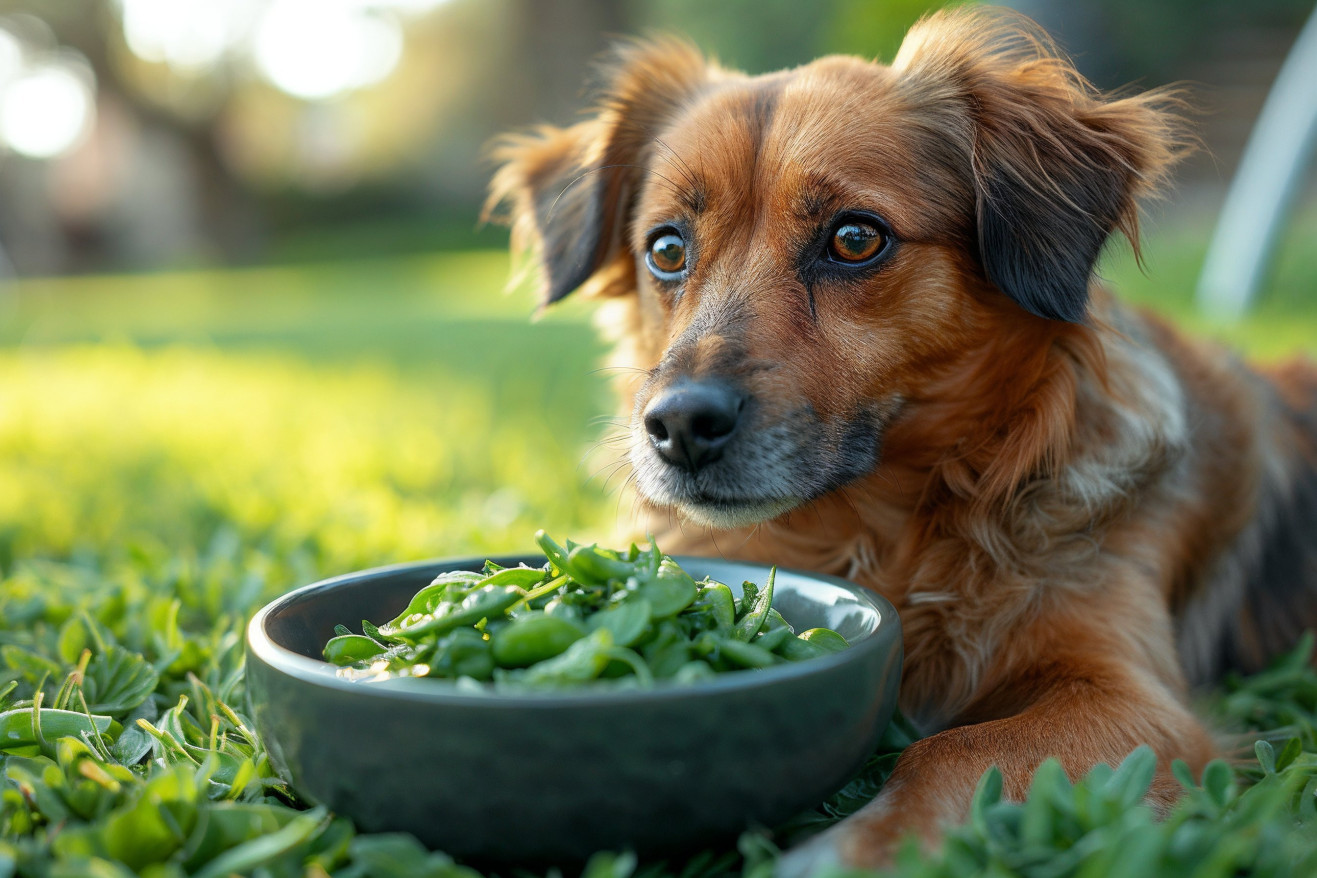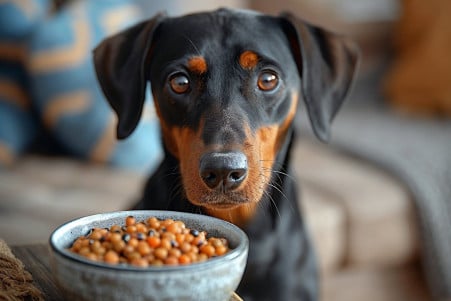Are Snap Peas Good for Dogs? A Guide to Leafy Greens
4 February 2024

Snap peas are a staple in many of our favorite salads, but are they a healthy option for our four-legged friends? The answer is yes. Snap peas are good for dogs and can be a healthy, safe, and nutritious addition to their diet, as they are full of vitamins, fiber, and protein.
That said, snap peas should be fed to dogs in moderation, and if your dog has kidney issues, you should be especially cautious because snap peas are high in purines. Also, make sure to feed them fresh or frozen, as canned snap peas are high in sodium.
This article will explore veterinary perspectives, nutritional breakdowns, and research on the canine diet to help you understand the benefits and potential drawbacks of feeding snap peas to your dog. By looking at the nutritional content of snap peas and the dietary requirements of dogs, this article will cover the science and practicality of feeding your dog this vegetable so that you can be informed about this healthy, crunchy snack.
Are Snap Peas Good for Dogs?
Snap Peas Are Packed With Nutrients That Canine Diets Can Benefit From
While humans love snap peas for their sweet flavor and satisfying crunch, snap peas are packed with vitamins that can help dogs too. According to UNL Food, snap peas are packed with vitamins C and K, both of which are important for immune function, wound healing, blood clotting, and bone health.
These vitamins, along with the iron in snap peas, are also important for red blood cell production, which is important for overall health in dogs.
Dogs have a wide range of nutritional needs, including protein, fats, and carbohydrates, as well as essential vitamins and minerals. Snap peas are a great fit for these needs, as they are low in calories and packed with nutrients, while being low in fat and cholesterol, according to a comparison of snow peas vs. sugar snap peas by Healthline.
In fact, Verywell Fit explains that the fiber in snap peas is especially good for digestion, as it can help with regularity and blood sugar control, which is especially important for dogs who have diabetes or need help with weight management.
That said, it’s important to note that snap peas are high in natural sugars and fiber, and while these are good for dogs, they should be fed in moderation to avoid digestive upset.
While the soluble fiber in snap peas can help lower cholesterol levels, feeding too many snap peas can throw off a dog’s diet. By feeding snap peas in amounts that are tailored to your dog’s specific needs, you can ensure that your dog gets the benefits of snap peas without any of the drawbacks.
How to Feed Dogs Snap Peas
While snap peas can be a healthy addition to your dog’s diet, it’s important to introduce them in a way that’s safe and healthy for your pet. This means starting with a small amount and seeing how your dog reacts, according to PetMD.
If your dog doesn’t have any digestive issues, you can gradually increase the amount of snap peas you give them. Snap peas can be fed to dogs raw or cooked, but Rover.com recommends washing them thoroughly and serving them fresh or cooked without any added seasonings.
You can also try sprinkling chopped snap peas on top of your dog’s regular food to see if they’ll eat them that way.
It’s important to keep in mind that snap peas, like all treats, should only make up 10% of your dog’s daily caloric intake to avoid any digestive issues. You should also never feed your dog canned snap peas because of their high sodium content, which can lead to dehydration and other health problems.
In general, you should avoid adding any additives or seasonings to snap peas, as plain snap peas are always the safest and healthiest option for dogs.
You should also talk to your vet before you start feeding your dog snap peas regularly, especially if your dog has any underlying health issues. This way, you can make sure you’re feeding your dog snap peas in a way that will be most beneficial to their overall health with the help of a professional.
How to Add Snap Peas and Other Vegetables to Your Dog’s Diet
When considering a dog’s nutritional needs, it’s important to remember that dogs are omnivores with a carnivorous bias. This means that while dogs are best suited to a diet that includes animal proteins, they can also benefit from plant-based nutrients.
According to the American Kennel Club, vegetables like snap peas can provide nutrients that aren’t found in meat, like fiber, vitamins C and K, and antioxidants, which can help with skin, heart, and eye health.
The question of whether dogs should be fed a plant-based or meat-based diet is a matter of some controversy. While a plant-based diet may offer some benefits, most veterinary nutritionists agree that a mix of plant and animal-based foods is the best way to ensure all nutritional needs are being met.
As VCA Animal Hospitals notes, a dog’s diet should include a mix of plant and animal-based foods to promote overall health, including the six essential nutrients: water, proteins, fats, carbohydrates, minerals, and vitamins.
It’s important to remember the difference between essential dietary components and supplemental treats. Vegetables like snap peas are considered supplemental, meaning they add extra nutrients and variety to a dog’s diet but shouldn’t replace the essential components of proteins and fats that are necessary for a dog’s health.
This well-rounded approach to canine nutrition means that while your dog can have the occasional snap pea as a treat, their diet should still be primarily meat-based and nutritionally balanced.
How to Manage the Risks of Feeding Snap Peas to Your Dog
While snap peas and other vegetables can be a healthy addition to your dog’s diet, it’s important to understand the risks and potential allergic reactions they may pose. As VetDERM Clinic explains, food allergies in dogs are most commonly caused by a hypersensitivity to a specific protein in the diet, but can also be caused by certain vegetables. Symptoms can include skin problems, gastrointestinal issues, and respiratory problems.
While vegetables are not common allergens, they can still cause problems for some dogs. When you introduce new vegetables, do so carefully and monitor your dog for signs of an allergic reaction, such as itching, redness, or digestive issues. If you notice any of these symptoms, discontinue feeding the vegetable and consult your vet for guidance and treatment.
The American Kennel Club recommends that dog owners use caution when adding vegetables to their dog’s diet. While snap peas are safe in small amounts, it’s important to know the signs of digestive upset and act accordingly.
By introducing snap peas slowly and monitoring your dog’s reaction, you can help ensure that your dog can enjoy the benefits of snap peas and other vegetables without any negative effects. Pay attention to your dog’s reaction to new foods to help them stay healthy and happy in the long run.
How Fiber Impacts Your Dog’s Digestive System
While the dog’s digestive system is designed to process meat, it can also handle vegetables like snap peas. Dogs are omnivores, which means they can eat a variety of foods, including plant-based options that offer essential nutrients. According to WebMD, while not necessary, vegetables can be part of a dog’s diet, providing additional vitamins and fiber.
Dietary fiber is an important part of a dog’s diet, according to The Farmer’s Dog. It comes in two forms: soluble, which is a prebiotic that helps with digestion, and insoluble, which helps with stool formation. Snap peas, which contain both types of fiber, help with bowel regularity and support a healthy gut.
That said, it’s important not to overdo it. Consuming too many vegetables that are high in fiber can lead to digestive upset, including diarrhea and constipation.
Dog Food Advisor says it’s best to make sure you’re feeding your dog a balanced diet, especially since most commercial dog foods already contain the fiber dogs need. To make sure your dog is getting the right amount of fiber, it’s best to make sure that the snap peas you’re feeding them are in addition to the average fiber content of their regular food.
It’s important to talk to your vet before adding fiber to your dog’s diet. They can give you personalized recommendations based on your dog’s specific needs. By feeding snap peas as a healthy treat and making sure you’re following your vet’s advice, you can make sure you’re improving your dog’s diet while also making sure you’re not negatively impacting their digestive health.
Final Thoughts: Snap Peas as a Rewarding Treat
This article has provided an overview of the nutritional content of snap peas and how they fit into a dog’s diet. Snap peas are a great source of vitamins, fiber, and protein, and can be a healthy treat for dogs when fed in moderation.
The article has covered the best ways to introduce snap peas into your dog’s diet, including the importance of feeding them in combination with other healthy foods, controlling portion sizes, and avoiding unhealthy additives.
The article has also stressed the importance of a well-balanced diet that meets the nutritional needs of dogs and has included a warning about the potential dangers and allergens of vegetables. Finally, the article has looked at the digestive advantages and nutritional importance of fiber in a dog’s diet and has shown that snap peas can be a helpful addition when used appropriately.
In summary, it’s important to reiterate that snap peas are safe and healthy for dogs when they are fed in moderation. Always talk to your vet before adding new foods to your dog’s diet.
By learning about your options and understanding the benefits of vegetables like snap peas, you can help support your pet’s well-being. Being a good pet parent means being informed and leads to the reward of sharing life’s simple pleasures, including snap peas, with our beloved pets.


